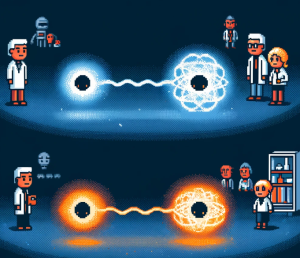
Quantum Teleportation: How Assisted Cloning Could Revolutionize Communication
Imagine a future where your most private information can travel instantly and securely across the globe, beyond the reach of hackers, spies, or even the most advanced artificial intelligence. This is not the stuff of science fiction—it’s the promise of quantum teleportation, a groundbreaking concept in quantum physics that has the potential to revolutionize how we communicate.
The Quantum Leap Forward
Quantum teleportation isn’t about transporting people like in Star Trek. Instead, it’s about transmitting information in the most secure way possible. Quantum teleportation uses the principles of quantum mechanics to send data from one location to another without physically moving the information itself. The potential applications are mind-boggling: from unhackable communication networks to lightning-fast computing that could leave today’s technology in the dust.
But there’s a catch—teleporting quantum information requires an intricate dance between multiple parties, each holding a piece of the puzzle. Ensuring the information reaches its destination intact and remains secure throughout the process has been one of the greatest challenges for scientists.
Enter Assisted Cloning: A New Protocol
In a recent study published in PLoS ONE, a team of researchers has proposed an innovative solution to one of quantum teleportation’s biggest challenges: how to clone quantum information perfectly across a network without compromising security. Their breakthrough? A protocol that allows for the cloning of an unknown quantum state, with the help of a state preparer, across multiple senders and receivers.
This might sound like a lot of technical jargon, but the implications are enormous. Imagine being able to send your data to multiple locations simultaneously, ensuring that it remains completely secure no matter where it ends up. That’s the power of assisted cloning in the realm of quantum information.
Breaking Down the Process: Quantum Teleportation in Action
To understand why this is so revolutionary, let’s take a step back and break down the process. Quantum teleportation relies on something called a GHZ-type state, a form of quantum entanglement where particles remain connected no matter how far apart they are (okay, yes, this does sound a bit like science fiction). Think of it as a cosmic telephone line, but instead of transmitting sound, it’s transmitting quantum information.
In the first stage of the new protocol, quantum information is teleported from an arbitrary number of senders to an arbitrary number of receivers using this entangled state. This is done without centralizing the information in any one place, ensuring that no single party has complete access to the data. It’s like sending pieces of a treasure map to different locations, with no one person holding all the clues.
But what happens when the information reaches its destination? This is where the second stage of the protocol comes in. The state preparer—let’s call them the “architect” of the operation—performs a series of measurements that allow the receivers to reconstruct the original quantum state perfectly. Not only that, but they can also create a complementary copy, ensuring that even if one version is lost or tampered with, the information remains intact.
Real-World Impact: Why This Matters Now
So why should you care about quantum teleportation and assisted cloning? The answer lies in the growing need for secure communication in our increasingly connected world. As we become more reliant on digital technologies, the risk of data breaches and cyber-attacks grows exponentially. Traditional encryption methods are struggling to keep up with the sophistication of modern threats.
Quantum teleportation offers a way to stay ahead of the curve. By transmitting information in a way that is fundamentally secure—where any attempt to eavesdrop on the transmission would be immediately detected—we can protect our data like never before. And with the new assisted cloning protocol, this security can be extended across entire networks, ensuring that our most sensitive information remains safe, no matter where it travels.
The Road Ahead: Challenges and Opportunities
Of course, this technology isn’t without its challenges. Quantum teleportation requires highly sophisticated equipment and conditions that are not easy to achieve outside of a laboratory setting. Additionally, the success of the protocol depends on the reliability of the quantum entanglement and the precision of the measurements.
But the potential rewards are too great to ignore. As researchers continue to refine these techniques, we can see the development of quantum networks that are not only faster and more secure than anything we have today but also capable of handling the massive amounts of data that our digital world demands.
Join the Conversation
As we stand on the brink of a quantum revolution, what do you think the future holds for communication technology? How might quantum teleportation change the way we interact with each other? And what ethical considerations should we keep in mind as we move closer to a world where information can be transmitted instantaneously and without error?
Join the conversation by sharing your thoughts in the comments below. Your insights could help shape the discussion on one of the most exciting advancements in modern science.
Join the Science Adventure
Stay updated with the latest discoveries in science! Our weekly newsletter is perfect for teachers and science enthusiasts. Get the newest research, major breakthroughs, and fascinating stories delivered to your inbox for free. Enhance your teaching and learning. Subscribe today! If you liked this blog, please share it! Your referrals help This Week in Science reach new readers.



